![]()
Roots of Prog Rock: Avant-garde, Classical, Folk, Jazz, Psychedelic and Rhythm and Blues.
What Prog Rock took from Psychedelic was the way of building up an atmosphere and a mood like lazy, tired and the alienation. And the Prog Rock musicians took the harmonic vocals arrangement from the folk movement. Tape effects, electronic sounds and noise were used, which most of these ideas was taken from avant-garde. Also, the Blues and Jazz were playing an important role in different bands. But the most important element to Prog Rock was the classical music.
King Crimson and Pink Floyd did take the advantages from avant-garde (sound experiments), Jazz, rhythm & blues (the instrumentation and improvisation). As the Prog Rock pieces featured long instruments passage and solo, vocals only took about 40% of a piece. And as a challenge to formal pop music and to express their ideas, plenty of their songs were longer than 20mins, which had dramatic arrangements, layers of texture, and involve key and tempo change.
And in the late 60's and early 70's, number of bands (not only Prog Rock bands) actually started recording with symphony orchestra, like The Moody Blues, and then the Nice, Deep Purple, Pink Floyd, Yes, etc. A trend of rock bands to dig in classical music was formed. Though not all result in successful, the groups drew on electric and electronic keyboards (many of them creations of the 60's) to simulate the classical tone colours that were so important to the genre.1
As keyboard players became concerned in the psychedelic era, this feature also passed to the Prog Rock movement, or simply bands at the time needed a new texture of sound. And most keyboard player in Prog Rock bands (Tony Kaye, Rick Wakeman, Keith Emersion) were classical trained. It's paradoxically to discuss whether the classical trained keyboard players brought classical influenced in rock music, or simply bands at the time needed a new texture of sound so asked keyboard players to join.
During the Prog Rock movement, acoustic instruments like acoustic guitar (Steve Howe) and flute (Ian McDonald, etc), which previously had played no role in rock music were used. Bass player and drummer also took their instrument to a new boundary, they played their instruments as melodic source rather than harmonic and rhythmic accompany:
The bass, is just as much a solo and melodic instrument as the guitar and even organ. - Chris Squire (the bassist of Yes) 3
Prog Rock drummers always had large drum kit on stage, more than any genre of rock. These percussion instruments were used to create an interesting sound rather than to emphasize the beats. And the Prog Rock drummers tended to use the upper part of the drum set (snare, toms, etc) more than kick drum, which could create an intricate set of rhythmic patterns that often contradict the downbeat.
How classical be digested were in few ways: to play classical pieces in rock style (ELP), or to arrange the song/album as a classical piece from instrumentation and multi-movement form (Yes). Furthermore, the Prog Rock bands used the term 'concept album' were in the same sense that 19th century composers used the term 'program'.3 In fact, I find that Prog Rock has some similarities to 19th century Romanticism and a table is drawn below:

For these series of genres, instruments fusion, we can say that Prog Rock was a movement that the musicians were all searching new sounds by different experience.
1 and 3. From Rocking the Classics by Edward Macan.
2. Quoted in Leonard Ferris, 'Yes' Bassist Chris Squire,' Guitar Player 7 (July 1973).
4. From All Music Guide@allmusic.com: Music Glossary: Styles.
As the table on the former pages, I wrote that the lyrics of Prog Rock were spiritual, philosophical, fanatical and mythical.
Except Pink Floyd who talked about real life problems (Money, Us and Them, etc), other Prog Rock bands took more surrealistic subjects. The ideas may come from Bibles, astrology, literature,1 fairytales and folklore. The lyrics were used to be implicative, which needed a deep reading to get the truth meaning. For this way of implication, I think it's about the middle class background of the musicians.2 And the mythical and spiritual lyrics were emerged from psychedelic movement, which greatly fascinated by the oriental religions.
Some may doubt the Prog Rock lyrics were escapism, but the truth meaning was always about life (Yes). Prog Rock lyrics also involved protest (Pink Floyd, ELP), political (Genesis, Pink Floyd). Most of the time we can see the lyricist strongly related to existentialism,3 which emphasized the loneliness of human nature and the drowning of human soul within a capitalize, materialize world.
1. Gensis' Selling England by the Pound was impressed by T. S. Eliot's The Wasteland; Yes' Close to the Edge was based on Hermann Hesse's Siddhartha and Pink Floyd's Animals was based on George Orwell's Animal Farm.
2. I'm going to discuss about this in the later chapter.
3. Existentialism was first announced in Paris by Jean-Paul Sartre (1905 - 1980) in 1945. Developed from the studies of Nietzsche (1844 - 1900) and Kierkegaard (1813 - 1855). Albert Camus (1913 - 1960), who wrote L'Etranger (1941). was also seen as an existentialist.
The visual played an important role in Progressive Rock: the album sleeve art and the live stage decoration. They acted as the extension of the sound and lyrics from the album, which also made the album to be a complete art work. And they were the elements to make so called concept album.
Cover ArtMaybe the use of visual art was started from the Beatles' Sgt. Pepper's again; the Beatles acted as a member of the Sgt. Pepper's Lonely Hearts Club Band on the cover and the mysterious cover was open to different interpretations on the songs and lyrics. Also this was the first rock album contained the complete lyrics of all songs.
The cover art usually reflected the album's concept or otherwise the most significant track. The media involved paintings, colleges and photography, or the combination of them. Most of them were in the style of surrealism, fantasy and mythological scenes, which could be found in the lyrics. And the covers themselves could be existed as individual art with their own beauty.
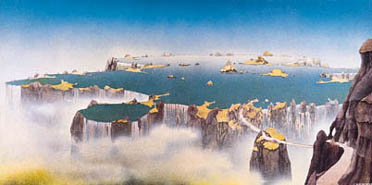
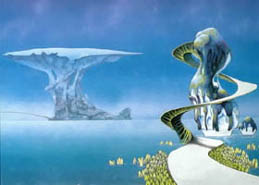
Roger Dean's on Yes
Most of the Prog Rock bands had their exclusive designer, Storm Thorgerson (the founder of Hipgnosis) on Pink Floyd, Paul Whitehead and Betty Swanwick (Selling England by the Pound) on Genesis, William Neal and H.R. Giger (Brain Salad Surgery) on ELP, Roger Dean on Yes.
The paintings Roger Dean did for Yes are another great work, which can even act as a visual symbol for Prog Rock. What he painted were some images of outer space, surreal landscape. They could be read as the places for escapists, or to me, I read them as subconscious, the inner sense of human and the ancient memories. My favourite Roger Dean works on Yes are the Tales from Topographic Oceans and Yessongs.
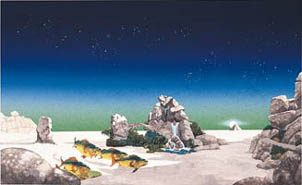
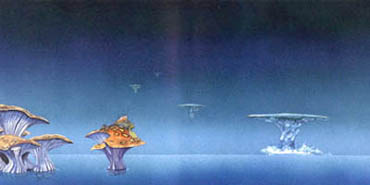
Roger Dean's on Yes
And sometimes the covers can be read as a series of related story. The spaceship (or the flying object) on Yes was going to land on a star in Fragile (the first cover Roger did for Yes), and the following albums were like what you've seen on the star and the spaceship reappeared again. And the Genesis' Nursery Cryme and Foxtrot by Paul Whitehead. You can see the characters from Nursery Cryme again on the Foxtrot cover.
Pink Floyd's covers design will be discussed in here for more details.
Live PerformanceLight effects, make up, installations, dry ice and smoke, etc. were used to decorate the stage as an extension to their concept of music in live. In fact, compare with other genre, Prog Rock musicians were not active on stage, except Keith Emerson and Peter Gabriel. It maybe the reason that multi media were used in live performance.
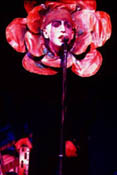

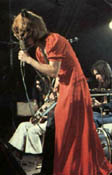
Peter the flower, Peter the fox!
The performance of Peter Gabriel in Genesis was always theatric and dramatic, as he would wear different handsets (flower, triangle, pair of wings, etc) and make up to act the characters in his music, I think it's an echo that Prog Rock did to the Glam Rock.
The live experienced of ELP seemed much simpler than the rest of other bands, mainly lights show and dry ice, etc. But they were the most powerful and energetic bands between, Keith Emerson played around huge of different synths were always a selling point.
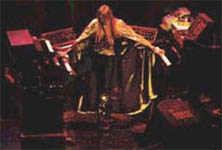
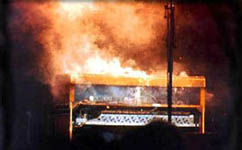
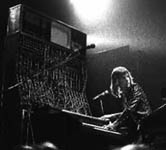
Rick Wakeman surrended by synths _ If Jimi Hendix played Hammond,burning Hammond by Keith Emerson
What Yes was difference from them were the installations Roger Dean and his brother Martyn designed, they showed their fantasy landscape on stage.
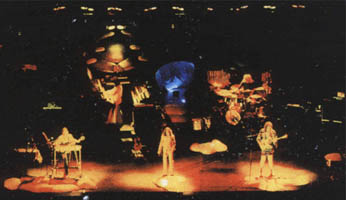
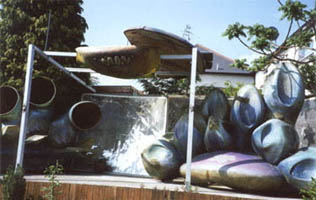
Yestage: On & Off
In the early period Pink Floyd did lots of light shows in live concert, and when they got to the stadium, huge installations were used. Their concerts at Earl's Court Exhibition Hall in London on May 18 and 19, 1973 are described as follows:
The concert opened with the familiar 'Set the Controls for the Heart of the Sun and 'Careful with that Axe, Eugene.' Dry ice smoke falling like a waterfall on' Echoes' led to the interval.
Dark Side of the Moon was played in its entirety. The stage was littered with landing beacons and spotlights searched the sky for airplanes. Finally a plane appeared followed by a spot [light] as it slowly flew over the audience and crashed into the stage, exploding in a ball of fire. The audience went wild... - Miles from Pink Floyd.
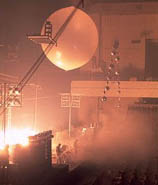
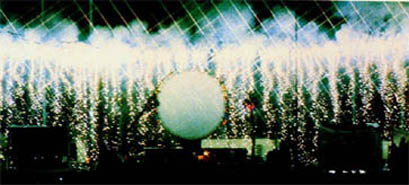
Floyd's on stage, take care of your eyes!
At the beginning it maybe a point to make the concert special but lately it became more important for playing in front of many audience in stadium, as they could not barely see the performers. Slowly, the gap between the musicians and the audiences grew.